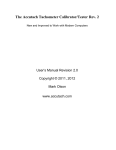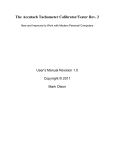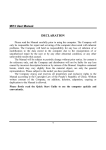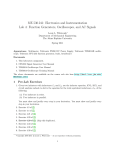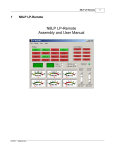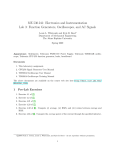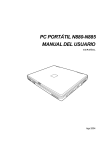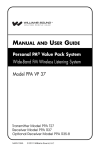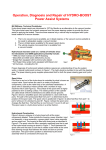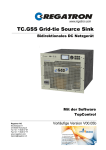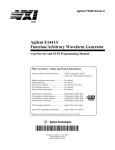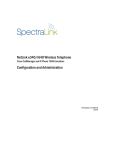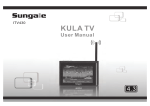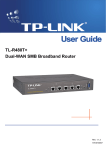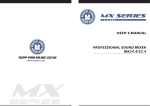Download The Accutach Tachometer Calibrator/Tester Rev. 2
Transcript
The Accutach Tachometer Calibrator/Tester Rev. 2 New and Improved to Work with Modern Computers User’s Manual Revision 2.3 Copyright © 2011, 2012 Mark Olson www.accutach.com The Accutach Tachometer Calibrator/Tester User’s Manual Table of Contents Table of Contents................................................................................................................1 System Requirements..........................................................................................................2 Identifying Hardware Revisions..........................................................................................2 Installation Guide................................................................................................................3 Selecting a Power Supply...................................................................................................5 Connecting the CSC unit to an inductively coupled tachometer (In the car).....................5 Connecting the CSC to a direct coupled tachometer (In the car)....................................,..6 Connecting the CSC to an inductively coupled tachometer (On the bench)......................8 Connecting the CSC to a direct coupled tachometer (On the bench)……........................10 Connecting the CSC to a Honda/Mustang Tachometer & Speedometer (On the bench).12 Using the PC Digital Signal Processor Software..............................................................14 Using the Android FuncGen Software……………..........................................................18 Testing, Debugging or Calibrating Tachometers & Speedometers…..............................21 Bench power supply considerations.................................................................................22 Tachometer background information (Smiths)................................................................23 Troubleshooting...............................................................................................................25 How to get product support.............................................................................................29 Disclaimer: This calibrator/tester was designed to work with inductively-coupled electronic tachometers such as the Smiths type found in Jaguars, Sunbeam Alpines, Sunbeam Tigers and most other vintage British sports cars. It was also designed to work with direct coupled tachometers as those found in 94-98 Ford Mustangs or 88-91 Honda Civics. This calibrator/tester was designed using techniques designed to minimize any chance of causing any damage to your tachometer and/or PC. However, Accutach is not responsible for any damage that might occur through the use or misuse of this www.accutach.com to product. Before you use this product, please check the Accutach web site (www.accutach.com) see if there is any last minute information you may need to safely use this product. Feel free to contact us before using this product on any tachometer should you feel unsure. Page 1 The Accutach Tachometer Calibrator/Tester User’s Manual The Accutach Tachometer Calibrator/Tester is designed to simulate high current automotive ignition signals for the Smiths tachometer used in many British cars of the 1960s and 1970s. It is also designed to simulate the voltage driven tachometer signals in more modern cars such as Ford Mustangs and Honda Civics of the 1980s and 90s. It is designed to aid in debugging, repairing and calibrating tachometers. It can also be used to calibrate some electronic speedometers as well. System Requirements The Accutach Tachometer Calibrator/Tester is a computer peripheral device. It relies on either a Microsoft Windows-base personal computer or an Android handheld device running a freeware program to operate. The computer must be an Intel compatible Personal Computer running Windows XP or newer. The Android Device must run Android 1.6 or newer (tested with a Google Nexus 7 tablet). Either device must have audio headphone output capability with a standard 3.5mm stereo headphone jack. The PC software used in this system is freeware Digital Signal Generator software found at http://heliso.tripod.com/download/generator/dsg.htm. http://heliso.tripod.com/download/generator/dsg.htm We have not been able to contact the author, but we thank him/her for making this software available for free. The Android Software used in this system is freeware FuncGen SignalGenerator software from Crescendo Systems, found here: https://play.google.com/store/apps/details?id=com.crescendosystems.afg&hl=en Calibrator Components Your Accutach Tachometer Calibrator/Tester consists of the following parts: This User’s Manual (Download from www.accutach.com) www.accutach.com The CSC (Current Switching Circuit) Unit 0.1uF capacitor (for electronic speedometer calibration) The following items are NOT included with the Calibrator/Tester: Power supply Intel compatible personal computer or Android device Digital Signal Generator software The power supply and personal computer can be purchased on-line or at a local electronic or computer retail store. The Digital Signal Generator software can be downloaded from http://heliso.tripod.com/ download/generator/dsg.htm Should this link ever fail, please check the Accutach web site download/generator/dsg.htm. www.accutach.com (www.accutach.com) Identification of Hardware Revisions The first revision of the Accutach Smiths Tachometer Calibrator can be identified by its 9-pin D serial port connector. Revision 1 is now obsolete. The second revision of the Accutach Smiths Tachometer Calibrator can be identified by its 35mm stereo audio plug. Page 2 The Accutach Tachometer Calibrator/Tester User’s Manual PC Installation Guide: This section of the instructions will tell you how to install the Digital Signal Generator software on your personal computer and how to connect the Tachometer Calibrator/Tester CSC unit to your computer. Installing the software on the computer: Open a browser and navigate to http://heliso.tripod.com/download/generator/dsg.htm http://heliso.tripod.com/download/generator/dsg.htm. Click on the Press here to download. link. Save the file (generator.rar) to a folder of your choosing. A .rar file is a compressed file similar to a .zip file. Now you will need to extract the program file from the compressed file. If your computer does not have a .rar file extractor, you can download the program FreeRARExtractFrog from http://download.cnet.com/Free-RAR-Extract-Frog/3000-2250_410804840.html 10804840.html. Follow the instructions to install it. Once you have the Digital Signal Generator .rar file saved, and have a .rar file extractor, extract the generator.exe file from the generator.rar file and save it in any folder you’d like on your computer. We recommend saving it to your desktop. Once you have the generator.exe file on your computer, there is no further installation required. The software will run when you double-click on the generator.exe file icon. Connecting the CSC to the personal computer: The Accutach Tachometer Calibrator/Tester Rev. 2 was designed to plug into a standard 3.5mm stereo headphone jack on a personal computer. First, make sure that your audio is not muted and the volume is set to maximum. Then simply plug the 3.5mm stereo headphone CSC plug into the jack. Page 3 The Accutach Tachometer Calibrator/Tester User’s Manual Android Installation Guide: This section of the instructions will tell you how to install the Digital Signal Generator software on your Android device and how to connect the Tachometer Calibrator/Tester CSC unit to your computer. Installing the software on the Android device: Open a browser and navigate to: https://play.google.com/store/apps/details?id=com.crescendosystems.afg&hl=en. Click on the Install link. The FuncGen Signal Generator application will be installed on your Android device. The software will run when you tap on the FuncGen icon. https://play.google.com/store/apps/details?id=com.crescendosystems.afg&hl=en Connecting the CSC to the Android device: The Accutach Tachometer Calibrator/Tester Rev. 2 was designed to plug into a standard 3.5mm stereo headphone jack. First, make sure that your audio is not muted and the volume is set to maximum. Then simply plug the 3.5mm stereo headphone CSC plug into the jack. If your Android device is a cellular phone, you must buy a 2.5mm cell phone jack to 3.5mm stereo jack adapter. Plug in here Page 4 The Accutach Tachometer Calibrator/Tester User’s Manual Selecting a Power Supply Most of the time, you will need a single well-regulated power supply that can supply up to one amp of current in a square wave. This is true for all inductively coupled tachometers, and for direct coupled tachometers that expect a signal that will go from 0 volts to the voltage that powers the tachometer. For example, a 12 volt inductively coupled Smiths tachometer will need only a single 12V power supply. This is true for both negative and positive ground tachometers. Direct coupled tachometers that expect an input that goes from 0 volts to the power supply voltage (for example 12V), then you will only need a single power supply. A charged car or motorcycle battery makes a very good well-regulated power supply, Most tachometers use a 12V supply voltage, although some may use a 6 volt supply. Battery chargers are not well enough regulated, unless they are connected to a charged car of motorcycle battery. Direct coupled tachometers that are powered by 12V, but expect a signal that is no larger than 0-5V will require both a 12V power supply for the tachometer and a 5V power supply for the CSC unit. The CSC unit will not work if powered by less than 5 volts and may be damaged if powered by more than 12 volts. It is a good idea to disconnect the CSC unit from power when it is powered at 12V and is not being used. It generates nearly 10 Watts and it gets quite hot. Connecting the CSC unit to a power supply: There are three test leads coming out of the CSC unit. There is a black lead with a black clip (negative power), a red lead with a red clip (positive power) and a lead with one color and a clip of the other color. That lead is the directly coupled tachometer signal. Connect the CSC unit red lead with the red clip to the positive terminal of the power supply and connect the CSC unit black lead with the black clip to the negative terminal of the power supply. Be sure to check the tachometer to see if it is a positive or negative ground unit before connecting it to its power supply, and connect it accordingly. Do not connect the CSC unit black lead with a red clip (or the red lead with a black clip) to anything unless you are driving a directly coupled tachometer. See the directly coupled tachometer sections below to see how to connect that lead. Connecting the CSC unit to an inductively coupled tachometer (In the car) An inductively coupled tachometer such as the Smiths tachometer used in Sunbeam products can be tested and the calibration checked while it is still in the car. The CSC receives its power from the ignition wire. The first step is to turn the car’s ignition key off and disconnect the ignition wire from the coil. DO NOT try to run the calibrator/tester without disconnecting the ignition wire from the coil or you could destroy the CSC unit. With a negative ground car, clip the red lead with the red clip to the ignition wire and clip the black lead with the black clip to a convenient ground. With a positive ground car, clip the black cliplead to the ignition wire and clip the red cliplead to a convenient ground. Do not let the third clip (the clip with one color and the lead with the other color) touch anything or you can destroy the CSC unit. We normally leave this lead clipped to the base of its own lead to keep it safe and out of the way. Page 5 The Accutach Tachometer Calibrator/Tester User’s Manual Warning: Make sure that the ignition wire and the red alligator clip do NOT touch ground during testing and calibration, or whenever the ignition switch is on. If they do, you’ll be lucky if you just blow a fuse in your car. If you are unlucky you may burn your car, garage and house down. It’s a good idea to put a rag or some other electrical insulator under the alligator clip. Also, needless to say, don’t do electrical work around gasoline fumes. Double check the power connections before turning on the ignition key. You can now go to the section entitled “Using the Digital Signal Generator Program”. Warning: The CSC unit dissipates 9W at 12V, so it gets quite warm if used for a long period of time with a 12V supply. This is normal, but you should exercise care when handling a hot CSC unit to avoid discomfort or injury. It is a good idea to disconnect the CSC unit from power when it is powered at 12V and is not being used. Connecting the CSC to a direct coupled tachometer (In the car) A direct coupled tachometer can also be tested and the calibration checked while it is still in the car. Some may even be calibrated while still in the car. The first step is to turn the car’s ignition key off and disconnect the tachometer wire from the coil or electronic ignition unit. DO NOT try to run the calibrator/tester without disconnecting the tachometer wire from the coil or you could destroy the CSC unit. With a negative ground car, clip the red lead with a red clip to the car’s positive power source (ground on on positive ground car) and clip the black lead with a black clip to a the negative power source (ground on a negative ground car). Some more modern tachometers may expect a 0-5V signal, in which case you must power the CSC unit with a 5V well regulated bench power supply. Clip the black lead with the red clip (some units have a red lead with a black clip) to the tachometer wire. Warning: Make sure that the tachometer wire and the alligator clip do NOT touch ground during testing and calibration. It’s a good idea to put a rag or some other electrical insulator under the alligator clip. And, needless to say, don’t do electrical work around gasoline fumes. Warning: The CSC unit generates a direct coupled tachometer signal that varies between 0 and the voltage that your power supply provides. If your direct coupled tachometer needs a 0-5V input signal, make sure you use a 5 volt power supply to power the CSC unit. If you power the CSC unit with a 12V supply, it will generate a 0-12V signal. If your direct coupled tachometer requires a 0-12V input signal, make sure you use a 12 volt power supply to power the CSC unit. Some tachometers can handle either 0-5v or 0-12V signals It is your responsibility to ensure that the signal from the CSC unit to the input of your direct coupled tachometer will not damage it.. Double check the power connections before turning on the ignition key. You can now go to the section entitled “Using the Digital Signal Generator Program”. Warning: The CSC unit dissipates 9W at 12V, so it gets quite warm if used for a long period of time with a 12V supply. This is normal, but you should exercise care when handling a hot CSC unit to avoid discomfort. It is a good idea to disconnect the CSC unit from power when it is powered at 12V and is not being used. Page 6 The Accutach Tachometer Calibrator/Tester User’s Manual Connecting the CSC to an inductively coupled tachometer (On the bench) You will need to obtain some sort of power supply in order to test or calibrate tachometers on the bench. Please refer to the section entitled “Selecting a Power Supply” for a discussion of suitable and nonsuitable bench power supplies. When removing the tachometer from the dash, be careful not to lose the knurled nut, lockwasher and “U” shaped metal bracket that hold the ignition wire loop to the back of the tachometer. Leave any plastic material holding the ignition wire in a loop on the wire. Be sure to take the “U” bracket with the tachometer as they are required for calibration. Do not lose the nut and lockwasher that holds the bracket. First, put one leg of the tachometer’s “U” shaped bracket through the loop in the CSC unit’s red cliplead wire as shown in the drawing. With the wire loop through the “U” shaped bracket, attach it to the back of the tachometer. Attach the red cliplead to the 5V to 12V power supply for the CSC unit. Attach the CSC unit’s black cliplead to the supply’s ground connection. If the tachometer is a negative ground unit, attach the 12V tachometer power supply to the bayonet connector on the back of the case and attach the tachometer power supply ground to the case, or a ground connection if the case is removed. If the tachometer is a positive ground unit, attach the tachometer power supply ground wire to the bayonet connector on the back of the case and attach the 12V tachometer power supply to the case, or an internal ground connection if the case is removed. Page 7 The Accutach Tachometer Calibrator/Tester User’s Manual Attach the red cliplead to the 5V or 12V power supply for the CSC unit. Attach the CSC unit’s black cliplead to the supply’s ground connection. If the tachometer is a negative ground unit, attach the 12V tachometer power supply to the bayonet connector on the back of the case and attach the tachometer power supply ground to the case, or a ground connection if the case is removed. CSC Unit Positive Lead CSC Unit Ground Lead Power Supply Ground Lead Power Supply Positive Lead Negative Ground Tachometer Screws attach tachometer to case If the tachometer is a positive ground unit, attach the tachometer power supply ground wire to the bayonet connector on the back of the case and attach the 12V tachometer power supply to the case, or an internal ground connection if the case is removed. Power Supply Positive Lead CSC Unit Ground Lead CSC Unit Positive Lead Power Supply Ground Lead Positive Ground Tachometer Page 8 The Accutach Tachometer Calibrator/Tester User’s Manual Connecting the CSC to a direct-connect Smiths tachometer (eg Series 3 E-type Jaguar) Attach the red cliplead to the 12V (positive) power supply (regulated or battery) connection. Attach the CSC black clip lead to the 12V power supply ground (negative) connection. Attach the 12V tachometer power supply to the Tachometer power connector (Green wire in the case of the S-3 E-type Jag) and attach the tachometer power supply ground to the case,or a ground connection if the case is removed. Attach the CSC unit's Signal red lead with a black clip (or vice versa) to the tachometer input connection (White wire with Blue stripe in the case of the S-3 E-type Jag). You can do the same connections at the ballast resistor connector to check the calibration in the car, using any chassis ground: Note the hole for accessing the calibration pot. If your tachometer has this hole, you do not need to disassemble the tachometer to calibrate it. Ground for the CSC unit and the tachometer Battery power for The CSC unit and the tachometer CSC Calibration signal: Red wire with Black clip or Black Wire with Red clip Note that I temporarily added a ground lug to the PCB mounting screw to make it easier to ground the tachometer for debug and calibration. Ground for the CSC unit and the tachometer CSC Calibration signal: Red wire with Black clip or Black Wire with Red clip Battery power for The CSC unit and the tachometer Page 9 The Accutach Tachometer Calibrator/Tester User’s Manual If the Smiths tachometer needs to be taken out of its case for calibration or repair, do not pry the metal tabs on the bezel or the bezel will never fit properly on the case again. Twist the bezel in either direction until the slots in the case line up with the tabs on the bezel. The bezel, trim ring, gasket and glass can then be pulled off the front of the case. It can be very difficult to break the bezel free. We use a pair of plastic handled rubber strap wrenches to get the bezel to rotate on the case. To remove the tachometer from the case, hold the power lug and “U” bracket stud between two fingers to hold the tachometer in the case as you remove the two tachometer mounting screws on the rear of the case. Once the two screws are removed, cup your other hand under the front of the tachometer to catch the face by its edges as it falls out of the case when you release your two fingers from the back. Try not to let the weight of the tachometer fall on the needle. For inductively coupled tachometers the wire loop is set up the same with the tachometer out of the case as it is in the case. The power lug is connected the same way out of the case as it is in the case. The case ground connection is made to the end of the large resistor that connects the two tachometer circuit boards together. Use the end of the resistor that is connected to the trace that goes to the metal frame of the tachometer. Double check the power connections before turning on the power supplies. You can now go to the section entitled “Using the Digital Signal Generator Program”. Connecting the CSC to a direct coupled tachometer (On the bench) You will need to obtain some sort of power supply in order to test or calibrate tachometers on the bench. Please refer to the section entitled “Selecting a Power Supply” for a discussion of suitable and non-suitable bench power supplies. When removing the tachometer from the dash and/or the instrument cluster, be careful not to lose any of the parts. The same care should be taken if the tachometer needs to be disassembled for calibration. Attach the red cliplead to the +5V or +12V power supply for the CSC unit, depending on the input requirements of the tachometer. Attach the CSC unit’s black cliplead to the supply’s ground connection. If the tachometer is a negative ground unit, attach the tachometer power supply to the tachometer’s power connection and attach the power supply’s ground to the tachometer’s ground. I do not know of any positive ground direct coupled tachometers, but if you have one, attach the power supply ground wire to the tachometer’s power connector and attach the +12V power supply to the case, or an internal ground connection if the case is removed. 1971-1975 Series-3 E-type Jaguar tachometers are all negative ground tachometers and should be connected as shown on the previous page. Attach the black wire with the red cliplead to the tachometer’s ignition connector. Double check the power connections before turning on the power supplies. You can now go to the section entitled “Using the Digital Signal Generator Program”. Page 10 The Accutach Tachometer Calibrator/Tester User’s Manual Connecting the CSC to a direct coupled 88-91 Honda Civic/CRX tachometer (On the bench) The Honda tachometer signal must be at least 5.7V in magnitude, and it can easily handle 12V. So you can use one 12V power supply to calibrate these tachometers. Locate the tachometer power, ground and signal terminals. Connect the power supply positive lead to the red CSC unit power lead, and the tachometer power terminal. Connect the power supply negative lead to the black CSC unit power lead and the tachometer ground terminal. Connect the CSC Unit tachometer lead (opposing colors lead) to the tachometer signal terminal. We used red, black and green extension clipleads for power, ground and signal for convenience: Signal +12V Power Ground Connecting the CSC to a direct coupled 94-98 Ford Mustang tachometer (On the bench) The Mustang tachometer signal must be at least 5.4V in magnitude, and it can easily handle 12V. So you can use one 12V power supply to calibrate these tachometers. Locate the tachometer power, ground and signal terminals. Connect the power supply positive lead to the red CSC unit power lead, and the tachometer power terminal. Connect the power supply negative lead to the black CSC unit power lead and the tachometer ground terminal. Connect the CSC Unit tachometer lead (opposing colors lead) to the tachometer signal terminal. We used red, black and green extension clipleads for power, ground and signal for convenience: Must also be grounded for a V8 tachometer. Leave disconnected for a V6 tachometer Signal +12V Power Ground Page 11 The Accutach Tachometer Calibrator/Tester User’s Manual Connecting the CSC to a 94-98 Ford Mustang Speedometer (On the bench) The 94-98 Ford Mustang speedometer can be driven by the tester/calibrator as well. It expects an 8000 pulse per mile AC signal. Locate the speedometer power, ground and signal terminals. There are 2 power terminals for the Mustang Speedometer. Connect the power supply positive lead to the red CSC unit power lead, and the 2 speedometer power terminals. Connect the power supply negative lead to the black CSC unit power lead and the speedometer ground terminal. Connect the CSC Unit tachometer lead (opposing colors lead) to the speedometer signal terminal through a 0.1uF capacitor. We used red, black and green extension clipleads for power, ground and signal for convenience: Power Signal Ground Power 0.1uF capacitor It is a good idea to disconnect the CSC unit from power when it is powered at 12V and is not being used. It generates nearly 10 Watts and it gets quite hot. Page 12 The Accutach Tachometer Calibrator/Tester User’s Manual Using the Digital Signal Processor Personal Computer Software Double-click on the generator.exe icon in the folder you extracted it to. You will see a window that looks like this: Square Wave Sweep(Lin) Settings D/A Output Add Exit You will only need to use five of the buttons: Square Wave, Sweep(Lin), Settings, D/A Output, Add and Exit. Click on the Settings button. You will see a window that looks like this: Page 13 The Accutach Tachometer Calibrator/Tester User’s Manual Click on the down arrow next to the Type field and you will see a window like this: Select Square Wave. You will see a window that looks like this: Enter 100.0000 in the Fre1. box and click on the Set button. There is no reason to change any of the other default settings. You will see a window that looks like this (don’t worry about the 0.1 in the Fre2. box.): Click on the Close button. Page 14 The Accutach Tachometer Calibrator/Tester User’s Manual You will see a window that looks like this: Click on the Add button until the waveform reaches its maximum size (maximum audio volume). Click on the D/A Output button. You will see a window that looks like this: Unplug the CSC unit from the PC’s headphone jack. Click on the Circle button. This will cause the PC to make a continuous 100Hz buzzing sound from the speakers. (clicking the Single button will cause the PC to make a 100Hz buzzing sound for 18 seconds only.) Make sure you maximize the volume before plugging the CSC unit’s plug back into the PC’s headphone jack. At this point, you can power up the tachometer and the CSC unit. You will be driving the tachometer with a 100Hz signal. Click on the Close button to stop the signal. To restart the signal, click on the D/A Output button and then the Circle button again. Page 15 The Accutach Tachometer Calibrator/Tester User’s Manual You must stop the signal by clicking on the Close button prior to changing the frequency of the signal. You will again see a screen that looks like this: Click on the Settings button. You will see a window that looks like this: Enter 533.33333 in the Fre1. box, then click the Set button followed by the Close Button. Click on the D/A Output button, and then click on the Circle button to start the signal generator running again. If you unplug the CSC unit from the headphone jack you will hear a higher frequency (533Hz) buzz. Page 16 The Accutach Tachometer Calibrator/Tester User’s Manual Sweeping the Needle with a PC It is often a good idea to sweep the needle to see if there are any RPMs at which the tachometer behaves strangely. To set up a sweep from one RPM to another, click on the Settings button to bring up the settings window: Enter the frequency for the starting RPM in to the Freq1. box and for the ending RPM in the Freq2. box. Click the Set button followed by the Close button. The signal generator is now set to sweep the needle. Click on the D/A Output button to bring up this window: (Select sine wave to sweep speedometers and square wave to sweep tachometers.) Click on the Single button to sweep the needle once or click on the Circle button to sweep the needle repeatedly. Page 17 The Accutach Tachometer Calibrator/Tester User’s Manual Using the Android FuncGen Signal Generator Software Tap on the FuncGen icon. You will see a window that looks like this: Square Wave Sweep toggle Frequency Settings ... Start You will only need to use five of the functions: Square Wave, Frequency, Sweep, Settings and Start. If you don’t want to sweep the tach, you can simply set the frequency at which you want to drive the tach, select Square wave and tap start. If you want to sweep the tach, you will need to tap the three-dot settings icon and then tap the Modulation Parameters icon. You will see a screen that looks like this: Linear Sweep Sweep Time (seconds) Starting Frequency Page 18 Ending Frequency The Accutach Tachometer Calibrator/Tester User’s Manual To sweep the tach, you will need to tap the Linear button to select it. Then set the Time to 10, which tells the software to sweep from the minimum frequency to the maximum prequency every 10 seconds. Set the minimum and maximum frequencies you want to sweep between. Linear Sweep Sweep Time (seconds) Starting Frequency Ending Frequency Page 17 Tap on the Back icon to go back to the main screen. Tap OK if it notifies you that the parameters have been reset. Tap Square, Sweep and Start to start to sweep the tach needle. (Note that this sweep sweeps the needle up only, not up and then back down again.) Square Wave Sweep toggle Page 19 Frequency Settings ... Start The Accutach Tachometer Calibrator/Tester User’s Manual Testing, Debugging or Calibrating Tachometers Four stroke motors fire the ignition for one half of the cylinders during each revolution of the crankshaft. So an 8 cylinder engine fires 4 times per rev, a 6 cylinder engine fires 3 times per rev, a 5 cylinder engine fires 2.5 times per rev and a 4 cylinder engine fires 2 times per rev. Since there are 60 seconds in one minute, the tachometer signal frequency in Hz can be calculated using the following formula: Freq. = (RPM/60)* the number if ignition events per revolution. 4 cyl. freq. = RPM/30 5 cyl. freq. = RPM/24 6 cyl. freq. = RPM/20 8 cyl. freq. = RPM/15 10 cyl. freq. = RPM/12 12 cyl. freq. = RPM/10 This table tells you the frequencies to enter into the Digital Signal Generator in order to simulate ignition signals at different RPMs: RPM 4 cyl freq. 5 cyl freq. 6 cyl freq. 8 cyl freq. 10 cyl freq. 12 cyl freq. 500 16.66667 20.83333 25 33.33333 41.666667 50 1000 33.33333 41.66667 50 66.66667 83.333333 100 1500 50 62.5 75 100 125 150 2000 66.66667 83.33333 100 133.3333 166.66667 200 2500 83.33333 104.1667 125 166.6667 208.33333 250 3000 100 125 150 200 250 300 3500 116.6667 145.8333 175 233.3333 291.66667 350 4000 133.3333 166.6667 200 266.6667 333.33333 400 4500 150 187.5 225 300 375 450 5000 166.6667 208.3333 250 333.3333 416.66667 500 5500 183.3333 229.1667 275 366.6667 458.33333 550 6000 200 250 300 400 500 600 6500 216.6667 270.8333 325 433.3333 541.66667 650 7000 233.3333 291.6667 350 466.6667 583.33333 700 7500 250 312.5 375 500 625 750 8000 266.6667 333.3333 400 533.3333 666.66667 800 8500 283.3333 354.1667 425 566.6667 708.33333 850 9000 300 375 450 600 750 900 9500 316.6667 395.8333 475 633.3333 791.66667 950 10000 333.3333 416.6667 500 666.6667 833.33333 1000 10500 350 437.5 525 700 875 1050 11000 366.6667 458.3333 550 733.3333 916.66667 1100 To calibrate a tachometer, select the frequency that corresponds to the RPM you want for the engine the tachometer is for, and start the signal generator. Power up the tachometer and the CSC unit The tachometer needle should move somewhere on the tachometer face. At this point, turn the tachometer’s calibration potentiometer until the needle points to the correct RPM for the frequency you chose. Page 20 The Accutach Tachometer Calibrator/Tester User’s Manual Testing, Debugging or Calibrating Speedometers Many electronic speedometers depend on an vehicle speed signal, such as that in 1994-1998 Ford Mustangs. The Mustang speed signal generates 8000 pulses per mile. Since there are 3600 seconds in an hour, and 8000 pulses in a mile, calibration frequencies can be calculated with this formula: Freq. = (8000/3600)*MPH = 2.22222…*MPH This table tells you the frequencies to enter into the Digital Signal Generator in order to simulate VSS signals at different speeds: MPH Freq. Hz 10 22.22222 20 44.44444 30 66.66667 40 88.88889 50 111.1111 60 133.3333 70 155.5556 80 177.7778 MPH Freq. Hz 90 200 100 222.2222 110 244.4444 120 266.6667 130 288.8889 140 311.1111 150 333.3333 160 355.5556 To calibrate a speedometer, select the frequency that corresponds to the speed you want, and start the signal generator. Power up the speedometer and the CSC unit The speedometer needle should move somewhere on the speedometer face. At this point, remove the speedometer’s needle and replace it on the speedometer shaft so that it points to the correct speed for the frequency you chose. You can drive the tachometer up to 180 degrees from the 0 MPH mark without problem. If you try to drive it much more than 180 degrees, the needle will not move. If you drive it too close to 180 degrees, the needle will go there, but peg the speedometer to the bottom of the pin when you turn off the calibrator. It can be difficult to get it to move back to 0 MPH, so it is not advised to calibrate the speedometer above 180 degrees from the 0 MPH mark. Page 21 The Accutach Tachometer Calibrator/Tester User’s Manual Bench power supply considerations On the bench, you will need a good, well-regulated power supply to power the tachometer and the CSC unit. The tachometer requires a well-regulated 12V supply while the CSC unit requires a 5V to 12V supply. I don’t have power consumption specifications for the tachometers, but they don’t seem to require too much current to operate. However, it is very important that the 12V supply to the tachometer be a very clean, steady 12V. Ripple or noise on the power signal will confuse the tachometer completely. A 12 battery charger can’t be used, for example, because there is far too much ripple in the power supply and it can’t respond well to sudden changes in current. The CSC unit uses nearly 10 watts when it is not being driven by the computer. It is a good idea to disconnect the CSC unit from power when it is powered at 12V and is not being used. When the calibrator/tester is driving the tachometer with a signal, the CSC unit draws a maximum current of 1/4 Amp if powered by a 5V supply to 1/2 Amps if powered by a 12V supply. Clearly, the CSC unit will run considerably cooler when powered by a lower voltage supply. A charged 12V car battery is a very well-regulated power supply for bench testing tachometers. An ideal bench setup is a small, regulated 12V supply for powering the tachometer and a separate, larger well-regulated variable supply for powering the CSC unit. The power supply in your computer should NOT be used, as the calibrator/tester could easily overload your supply or inject noise into the system that could cause your computer to have severe problems. Page 22 The Accutach Tachometer Calibrator/Tester User’s Manual Tachometer background information: This section is intended to give you some background information on tachometers to enable you to determine if the Accutach Tachometer Calibrator/Tester can help you calibrate your tachometer, help you do calibration, and, if you are real adventuresome, help you repair broken tachometers. I know of two types of electronic tachometers in cars, inductively coupled and direct coupled. Direct connect electronic tachometers have a direct electrical connection to the ignition circuit. These tachometers use voltage signals in the ignition circuit to drive the tachometer. Since there are so many types of direct coupled tachometers, I can’t describe them all. Most of them need to be disassembled in order to calibrate them. You need to look for an adjustment pot (or variable resistor) used to calibrate the tachometer. You also need to ensure that a 12V signal on the input will not hurt the device. The inductively coupled type of tachometer uses a one turn loop of the ignition wire as the primary side of a transformer that couples the current pulses caused by the car’s ignition circuit into the inside of the tachometer. The timing of those current pulses are used to drive the tachometer. The Accutach Tachometer Calibrator/Tester is designed to calibrate these type of tachometers. While this calibrator/tester will work with any inductively coupled electronic tachometer, it was developed and tested with Smiths tachometers from the mid 1960’s. These tachometers were used in Sunbeam Tigers and Alpines as well as in Shelby Cobras and many other British cars of the period. Since this is the tachometer I’ve had the most experience with, this is the tachometer I will describe in detail. The Smiths tachometer must be disassembled in order to calibrate or repair it. Carefully rotate the chrome bezel until the tabs on the bezel line up with the slots on the case. This can be a very difficult job if the seals have aged badly and stuck. Whatever you do, DON’T pry up the tabs on the bezel or you’ll ruin it. We use a pair of plastic strap wrenches with rubber straps to rotate the tough bezels. Don’t tap the bezel edge as the meter is very fragile. Once you get the chrome bezel off the tachometer, the face glass and inside bezel must come out, if they didn’t come out with the chrome bezel. Carefully pry the inner bezel from the case. It is not necessary to separate the glass from either bezel if it is stuck to one of them. Be careful prying on anything, especially if the glass is still in place, as it is very easy to damage it or the bezels. I have not been able to locate a source for the seals, so I just try to be very careful, and reuse what I can with what’s left of the seals. I always use a lint free cloth and glass cleaner to clean the glass while the tachometer is apart. Page 23 The Accutach Tachometer Calibrator/Tester User’s Manual Once the meter face is exposed, be very careful not to mar or get finger prints on the face or break the needle. The next step is to remove the tachometer innards from the case. There are four screws on the back of the case, two of which are recessed in holes in the case and two of which are not. The two in the recessed holes hold the innards of the tachometer together so don’t take them out. Put the tachometer case face down on the bench. While pinching the “U” bracket stud with one finger and the power spade lug with another to hold up the tachometer innards, remove both of the non-recessed screws. The tachometer innards are now being held in the case by your two fingers. Pick up the case and cup your other hand under the face of the case. Carefully let the stud and spade lug slide out of your fingers and catch the face of the tachometer by the edges in the cup of your hand. You can then pull the case off of the tachometer innards and turn it over. You are now ready to calibrate or debug the tachometer. This is a good time to slide a shield under the needle to shield the face and repaint the needle if you can find appropriate paint. (My artistic talents aren’t very good, so I never try that step myself.) Reassembly is the reverse of this process. Electronically, the Smiths tachometer is a relatively simple two Germanium transistor inductively coupled electronic tachometer. The following diagram shows the schematic of the tachometer: The two transistors together form a monostable multivibrator, or one-shot. Normally, the collector of Q1 is at 6V. An ignition pulse couples through the transformer to trigger a one-shot voltage pulse to 12V on the collector of Q1 for a set amount of time. Every time an ignition pulse is detected through the transformer, the collector of Q1 will pulse from 6V to 12V for a fixed amount of time. While the collector of Q1 is at 12V, the top of the meter is held at 6V by the Zener diode, so current will flow through the meter, causing the needle to deflect. The width of the voltage pulse is determined by the combination of the 0.25uF capacitor C2 and the combination of resistors R3, R4 and pot. R5. The one-shot is triggered by every ignition pulse, so the voltage waveform looks like a series of pulses when the engine is running. Since the pulses are fixed in width and the frequency of the pulses is determined by the engine speed, the ratio of the time the waveform is at 12V vs. 6V goes up with increases in engine speed and down with decreases in engine speed. The way the meter works, the more time the waveform is at 12V, the more the needle is deflected and the less time the waveform is at 12V, the less the needle is deflected. To calibrate the meter, you want to drive the tachometer with a very accurate, known signal at the correct frequency for the RPM reading that you want on the meter. Once you are driving the tachometer with the accurate frequency, you can adjust the needle deflection to the proper place by turning the calibration pot. R5. The tachometer can only be calibrated at one RPM. After that, all you can do is check to see how close you are at other RPMs. Page 24 The Accutach Tachometer Calibrator/Tester User’s Manual It is possible to recalibrate the 7,000RPM Alpine 4 cylinder tachometers to work in V8 Tigers using this method. The most common failure modes I have seen are failure of the main timing capacitor C2. Failure of this cap. has caused tachometers to be erratic, temperature sensitive or just plain dead. If you suspect your tachometer to have this problem, locate the capacitor, carefully unsolder the capacitor, and replace it with a new one. I have not been able to locate a supply of 0.25uF capacitors, but available 0.22uF to 0.27uF capacitors work fine. I have yet to come across a tachometer with a failed transistor, but they are rumored to cause problems as well. The other major failure mechanism I have seen is a broken meter spring. The meter needs to be replaced in this case. Replacement meters must be gotten from a parts tachometer. As a matter of course, the tachometer will have to be recalibrated if any of the parts are replaced. All of the Smiths tachometers of this era use the same electronic and mechanical design, regardless of number of cylinders, positive or negative ground or the make of the car. The power and ground wires are reversed between tachometers for positive or negative ground cars. The only other thing that changes is the face used on the meters. So don’t throw away any vintage Smiths tachometers or tachometer parts. They can be used to resurrect any other one. Troubleshooting: This section attempts to explain how to find problems with the Accutach Tachometer Calibrator/ Tester or your test setup. If the tachometer is working in the car with the engine running, and you can’t get the calibrator to work with a tachometer in the car, first double check the cliplead attachment to the ignition wire and the ground, if it is an inductively coupled tachometer. If you are testing a direct coupled tachometer, ensure you have a good power, ground and tachometer input connections. Make sure they are connected correctly for positive or negative ground. Reclip the leads to ensure good electrical connections. Make sure the cable from the CSC unit to the personal computer is well seated. If the tachometer worked in the car with the engine running, and doesn’t on the bench, check the power supplies and polarities for both the tachometer and the CSC unit. Check to make sure you have the loop in the red cliplead through the “U” bracket correctly on the back of the tachometer, if it is an inductively coupled tachometer. Reclip the leads to ensure good electrical connections. Make sure the cable from the CSC unit to the personal computer is well seated. If the tachometer worked in the car with the engine running and it worked in the car with the calibrator/tester, and it doesn’t work on the bench, double check the power connections. If you are using a 5V supply for the CSC unit, try two loops through the “U” bracket if the tachometer is inductively coupled. If the tachometer didn’t work in the car and you want to ensure the calibrator/tester is working correctly, you will probably need to use an oscilloscope on the bench to see if the signal is being coupled through to the tachometer. If it isn’t, There could be a problem with the power connections, the loop on the “U” bracket, or the COM port as above. If there is no problem there, it could be the input transformer or transistor Q1. Page 25 The Accutach Tachometer Calibrator/Tester User’s Manual Page 26 The Accutach Tachometer Calibrator/Tester User’s Manual For your reference, here are the schematics for the tachometer from the Series-3 E-type Jaguar from 1971 to 1975. 1971-1975 Series 3 E-type Jaguar Tachometer Schematics Mark Olson 2012 68, 2W R6 BLU GRY BLK 25K 8 2 7 3 6 4 5 Ground (Case) Package Top View Page 27 R7 42 R8 R9 1 1 42 4.3K R2 0.1uF TI MIC7/C 6 4.7K YEL ORN RED 5 C3 U1 TI MIC7/C 2 290 RED WHT BRN Meter C2 0.047uF 15K YEL VIO RED R3 D1 8 YEL RED BLK YEL RED BLK 68 R1 3 4 C1 Tach Signal White/Blue BRN GRN ORN R4 7 BLU GRY BLK 64uF, 15V R5 Battery Voltage Green The Accutach Tachometer Calibrator/Tester User’s Manual How to get product support: The Accutach Tachometer Calibrator/Tester is a very robust design and should give you years of very good service. If it breaks due to anything other than flagrant abuse, I’ll repair it or replace it at my option for five years after purchase. You only need to pay the shipping and handling both ways. Before you send it back, write or give me a call to see if we can debug things first. I can be reached for support in the following ways: US Mail: Mark Olson 5467 Glennan Ct. San Jose, CA 95129 Internet: Day Phone [email protected] 1(408) 357-3541 Page 27





























